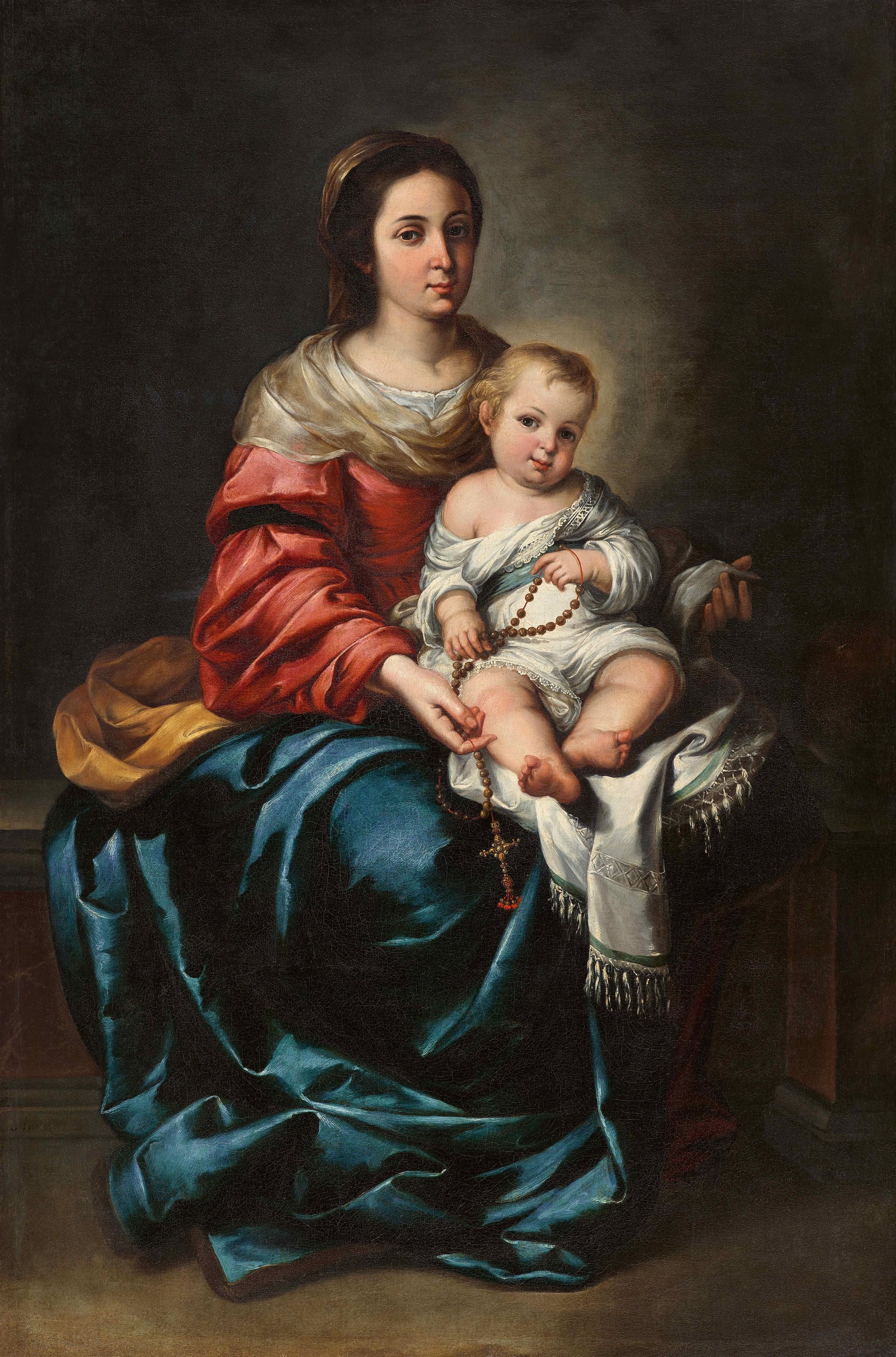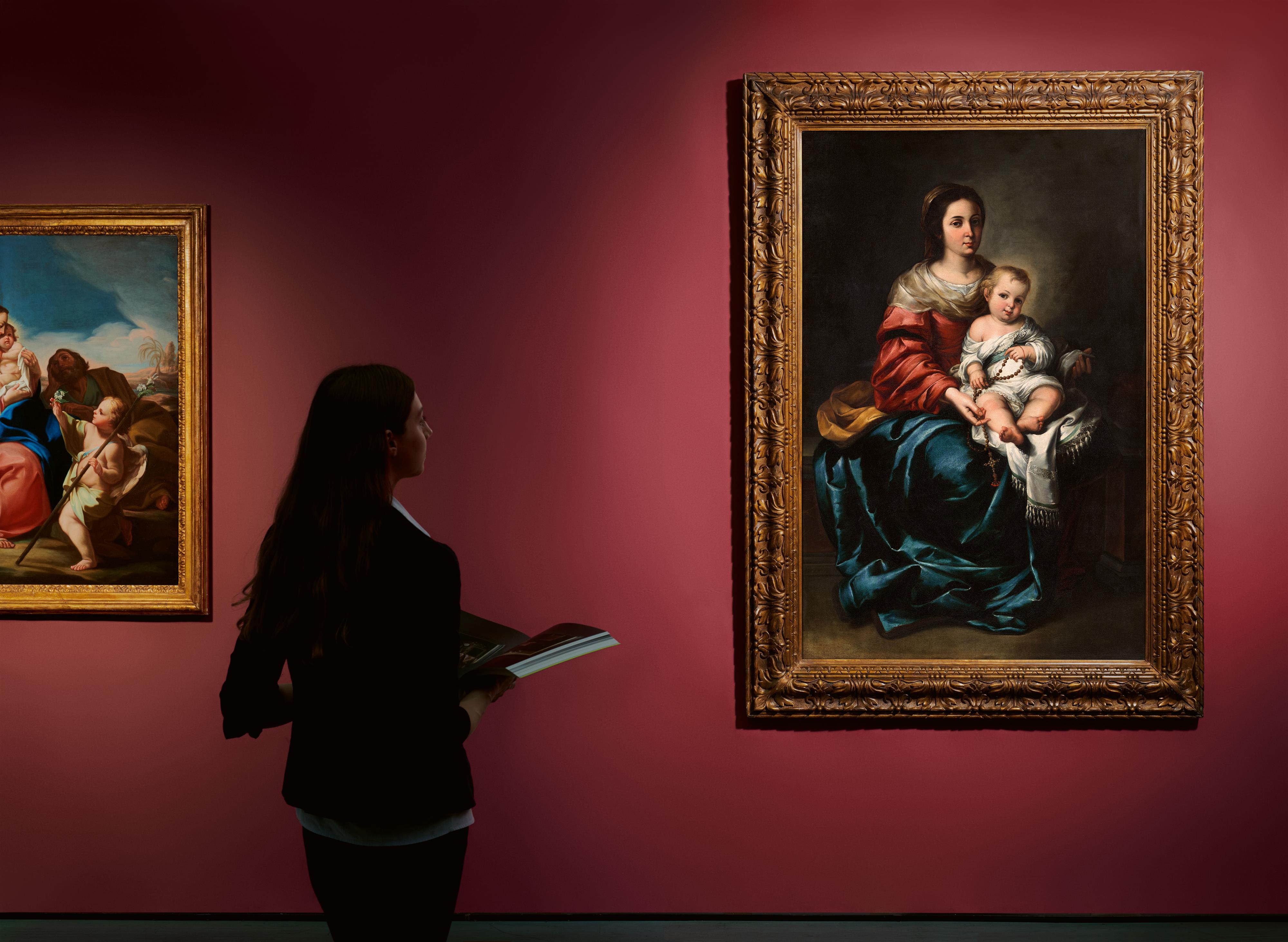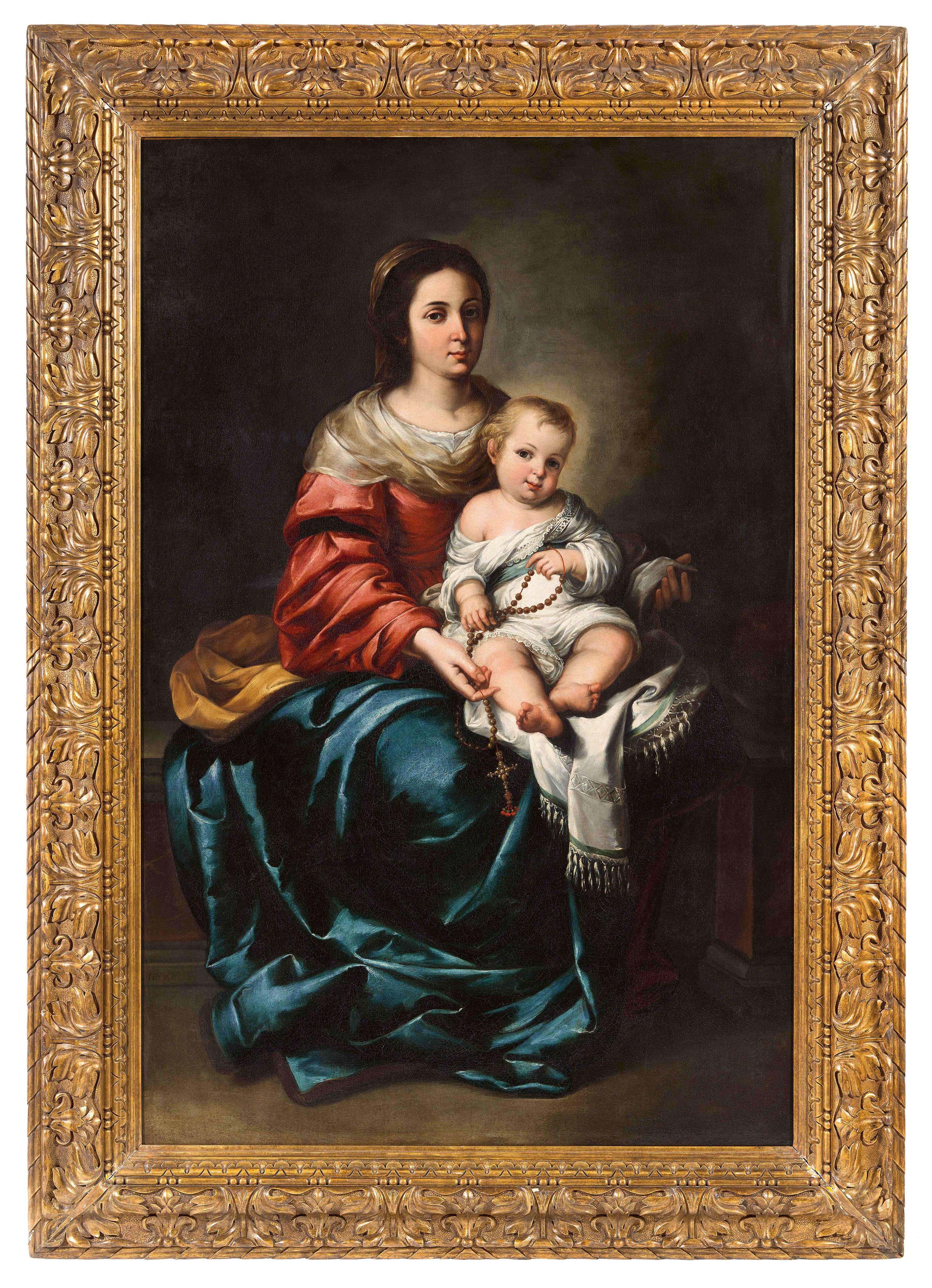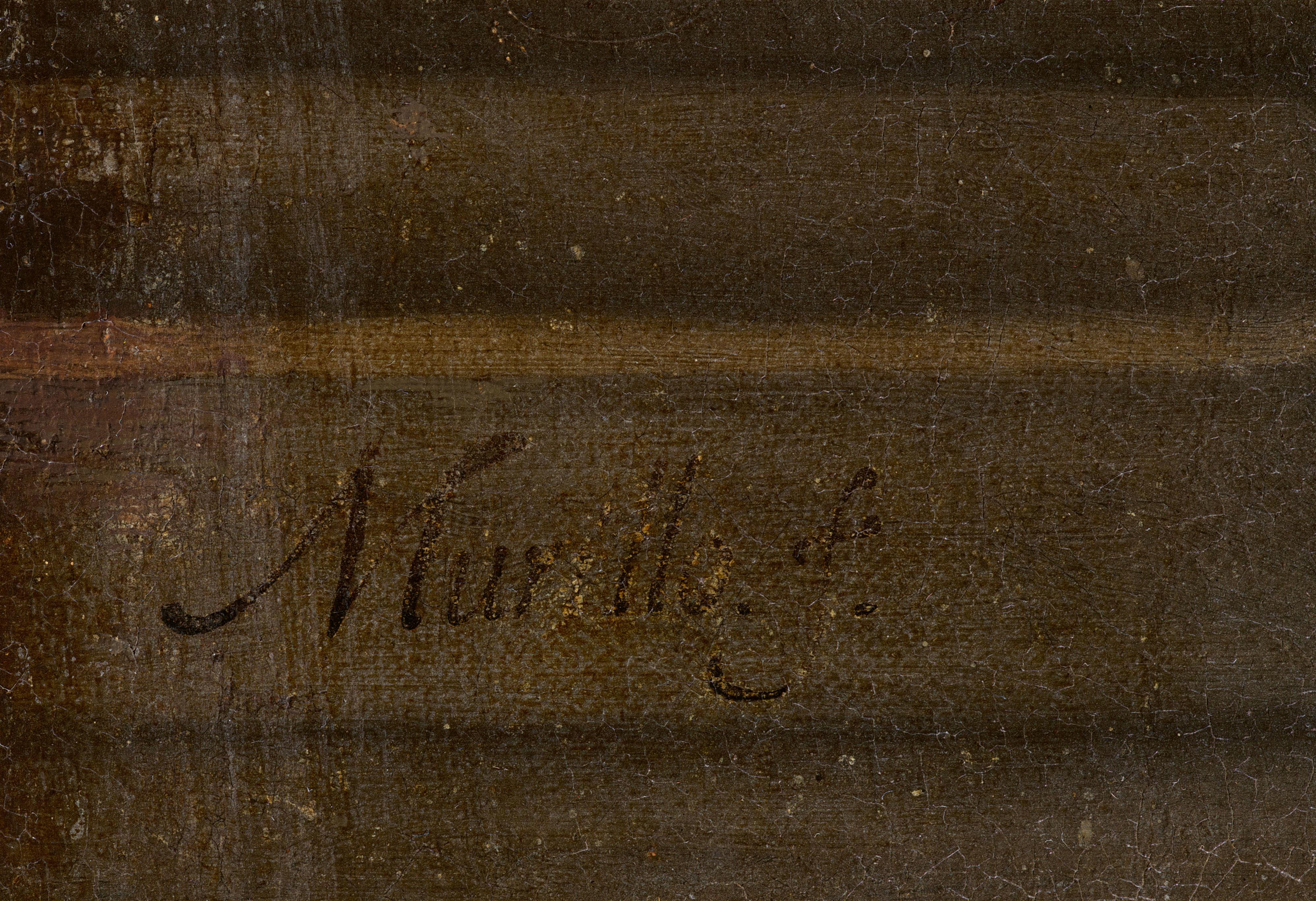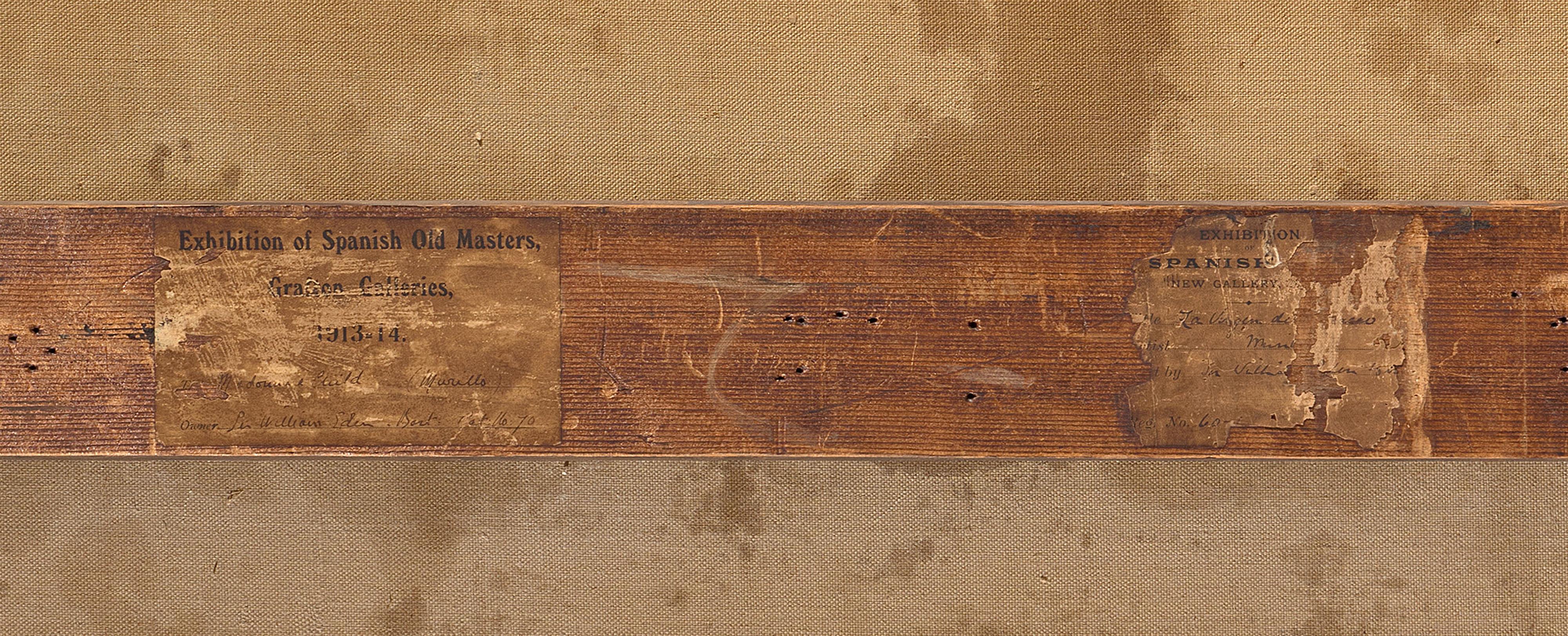Bartolomé Esteban Murillo
The Virgin of the Rosary
Oil on canvas (relined). 167,2 x 112 cm.
Signed lower left: Murillo f:.
Bartolomé Esteban Murillo was one of the most important masters of the "siglo de oro", the golden age of Spanish painting, and his works can be found in many of the great museums throughout the world. They are admired above all for the popular realism and the very human mysticism that characterizes Murillo's religious painting. The master from Seville, who left his home town only once in his life for a short trip to Madrid, painted a total of four panels with the motif of the "Madonna of the Rosary", two of which are particularly similar. One has been in the Palazzo Pitti in Florence since 1822 as a gift from the Grand Duke Ferdinand III of Lorraine, and the second is the work presented here, the only one of the four to be signed.
We know from various written sources of the 18th century that there was a "Madonna and Child" by Murillo in the sacristy of the Carmen Calzado Monastery in Seville. The large panel, which depicted the Madonna in life size, had apparently been commissioned by the Carmelites from the young painter who lived not far from the monastery. It remained "in situ" until the turmoil of the Napoleonic period, when ecclesiastical institutions were secularized and looted. Unlike many other important works of art that came on the market and were sold abroad at that time, this Madonna by Murillo apparently remained in Seville. For in 1833 it was acquired there by the Englishman Julian Benjamin Williams, a passionate art collector and art agent. In a recently published letter of January 1833 to William Eden in England, Williams writes that he had just acquired a magnificent life-size Madonna by Murillo. A year later, on 12th April 1834, he writes again to Eden, apparently answering him, "The Virgin del Rosario which you mention I conclude to be the large Picture by Murillo that I hang at the end of the long room on the right in the Centre space. The Virgen full length is seated with the child on her lap. It belonged to the Sacristia del Carmen Calzado and is mentioned in Cean, also in Pons, who calls it bellisima." (H. Brigstocke, op. cit. p. 120)
In the same year William Eden, 4th Baronet of Maryland (1803-1873) bought the painting and had it sent to his residence Windelstone House, Durham (H. Brigstocke, op. cit., p. 122). Murillo's "Madonna of the Rosary," occasionally called "Madonna Eden," remained in the family's possession for three generations until it was auctioned in London in 1933. It was then acquired by New York's Newhouse Gallery, which later sold it to the pianist José Iturbí. From the family estate of José Iturbí it was soldcompletely misjudged in 2008 at an auction in Los Angeles as "studio of Bartolomé Esteban Murillo", where it was acquired by the current owner (Bonhams, Los Angeles, 2.6.2008, lot 186).
For two centuries the panel enjoyed general admiration as a work of Murillo; first in the monastery itself, later in the Eden Collection and at two exhibitions of Spanish painting in London (1895/96 and 1913/14).
In his monograph on Murillo of 1913, Ludwig Mayer publishes the Eden Madonna without any reservations regarding the attribution based on an old photograph (L. A. Mayer, op. cit.). Why he changed his mind about the painting in 1934 and then considered it a copy is not known (L. A. Mayer, op. cit.,), nor whether he ever saw it in the original. What is certain, however, is that he mistook the very similar composition from the Palazzo Pitti for the panel from the Carmelite monastery in Seville, which is now disproved. Mayer's judgment about the painting was later adopted by Angulo Iniguez (op. cit., 1981). Also with him it is questionable whether he had seen the picture in the original, since its whereabouts were not known to him.
In the light of recent technological investigations and art historical studies by a younger generation of art historians such as Alvarez Calero, Ignacio Cano (H. Brigstocke, op. cit., p. 120) and Hugh Brigstocke (see literature), the "Eden Madonna" is again seen as a characteristic work from the painter's early period of maturity, painted around 1645/1650 for the Carmen Calzado convent in Seville. The painter seems to have wanted to explicitly confirm the importance of this commission with his signature.
Apart from the signature, the technological study carried out by Rafael Romero Asenjo and Adelina Ilán Gutierrez in 2013 brought to light another peculiarity of the painting. Murillo has worked on the grey primer of the cloak of the Madonna, consisting of lead white and bone black, only with pure, high-quality azurite. Since this material was particularly precious and correspondingly expensive, in other paintings he usually used a mixture of azurite or lapis lazuli with inferior pigments. This detail can also only be attributed to the fact that the painter was aware of the importance of the commission. Velazquez had already executed two works for the Carmelites of Seville before him, and Murillo himself painted an "Ecce Homo" for the monastery in addition to the "Madonna of the Rosary".
The canvas is prepared with brown ochre pigments, as was common in Seville in the 17th century. On the X-ray it can be seen that some parts of the figures have slight traces of an earlier under drawing. The Virgin is drawn with a direct and spontaneous technique, with some corrections in the outlines of the head and the left arm, as well as the fringes of the white cloth and the cross of the rosary, which is reduced and shortened. These observations are also convincing indications that this painting cannot be a copy after Murillo, but instead that it may even be the first version of this pictorial motif.
Provenance
Carmen Calzado convent, Seville until around 1810. – Presumably Manuel del Real Garcia, Seville. - Julian B. Williams, Seville. - Sold in 1834 to Sir William Eden, 4th Baronet of Maryland (1803 - 1873). - Thence by descent to his son Sir Robert Johnson Eden. - Thereafter to his son Timothy Calvert Eden. - Sotheby´s London 26.07.1933, lot 17. - The Newhouse Galleries, New York from 1934 - 1938. - Acquired there by the pianist José Iturbi in 1938. - Estate of José Iturbi and Marion Seabury 1980-2008. - Bonham's Los Angeles 2.6.2008, lot 186 (as B. E. Murillo, studio). - Acquired there by the current owner.
Literature
D. Ortiz de Zúñiga: Anales eclesiásticos y seculares de la Muy Noble y Muy Leal cindad de Sevilla, Tomo V 1796, p. 37. – F. Arana de Valflora: Compendio histórico descriptivo de la Muy Noble y Muy Leal ciudad de Sevilla, Metrópoli de Andalucía , primara parte, Sevilla 1798, p. 44. – J. A. Ceán Bermúdez: Diccionario de los más ilustres profesores de las Bellas Artes de España, Madrid 1800, II, p. 59. – E. Davies: The life of Bartolomé Esteban Murillo; compiled by various authors, London 1819, p. 95. – F. Gonzalez de León: Noticia Artística, histórica y curiosas de todos los edificios públicos y sagrados de la Muy Noble …, Sevilla 1844, vol. I, p. 199. – W. Stirling Maxwell: Annals of the artists of Spain, London 1848, vol. 4 p. 1610. – F. M. Tubino: Murillo, su época, su vida, sus cuadros, Sevilla 1864, p. 205. – C. B. Curtis: Velázquez and Murillo, London 1883, p. 152, no. 87. – M. F. Sweeter: Murillo, Boston 1879, vol. 5, p. 131. – P. Lefort: Murillo et ses élèves, suivi du catalogue raisonné de ses principaux ouvrages, Paris 1892, p. 74, no. 85. – C. Justi: Murillo, Leipzig 1892, p. 41. – L. A. Mayer: Murillo. Des Meisters Gemälde, Stuttgart/Berlin 1913, p. 27, illus. B. – L. A. Mayer: Anotaciones a obras murillescas. In: Boletín de la Sociedad Española de excursiones, XLII, Madrid 1934, pp. 14-18. – J. A. Gaya Nuño: La pintura española fuera de España, Madrid 1958, p. 242, no. 1865. – J. A. Gaya Nuño: L´Opera completa de Murillo, Milano 1978, no. 34. – D. Angulo Iñiguez: Murillo. Su vida, su arte, su obra, Madrid 1981, pp. 148-149 (about the painting in Florence, Palazzo Pitti). – A. J. Álvarez Calero: Dos cuadros desconocidos de Murillo que se hallaban en el convento Casa Grande del Carmen de Sevilla. In: Laboratorio de Arte 24, Sevilla 2012, pp. 301-314. – A. J. Álvarez Calero: Nuevas aportaciones sobre el cuadro “La Vírgen del Rosario” procedente del antiguo convento del Carmen de Sevilla atribuído a Murillo. In: Ucoarte. Revista de Teoría e Historia del Arte, 5, 2016, pp. 69-95. – H. Brigstocke: William Eden: The discovery of Murillo with his friends in Spain. In: I. Kent (ed.): Collecting Murillo in Britain and Ireland, Madrid/London 2020, pp. 99, 120, 122.
Exhibitions
London 1895/96: Exhibition of Spanish Art under the patronage of Her Majesty the Queen Regent of Spain, The New Gallery, catalogue pp. 28-29, no. 123. - London 1913/1914: Illustrated Catalogue of the Exhibition of Spanish Old Masters in support of National Gallery Funds and for the benefit of the Sociedad de Amigos del Arte Espanol, Grafton Galleries London, catalogue pp. 76-77, no. 70, ill. XXXII.

